Some thoughts on hackle ...or living with less than the best

This cree neck has small 'furnace' patches. Not a big deal, but it makes the neck inexpensive
Indian necks
Pick any unusual colour I can find especially if they are in the bargain bin.
Check for barb length and number of pin feathers. Check the feather out by bending to see how long the feather is from the "sweet spot." Use larger feather as parachute hackle. Different colour hackle have different standards.
Grizzlies are always good relative to others and so are red game. That means that if you pick a genetic grizzly you can go to #3 and still achieve reasonable quality. Duns, Creams and black centred hackle you will probably need the best quality, i.e. a #3 grizzly is nearly the equal of a #1 dun.
This means you can save by using lesser priced grizzlys and reds, and that one is better served to use the best blue duns, creams, badgers, furnaces, etc. Quality is relative to the feather type.
Compensating for size
You find the perfect coloured neck - probably an unusual dun, a greenwell or a furnace with colours to die for but you find that the feathers are too long.
What do you do? Buy it and use it to:
- Tie parachutes, hackle size is not that critical to parachutes. they can be oversized.
- Tie skaters and spiders with good quality oversized hackle. These flies can be deadly in difficult situations.
- You can use a dubbing loop to create the hackle size you need by trimming as needed at the base of the flue then lock in with a thread loop or poly or any suitable floating dubbing. There are some people who believe that the thorax outline is important for trout to recognize edibles.
- A technique that is used for soft hackle is to tie a hackle at another point in the hook and then bind down the hackle till you get to the eye, pull the hackle vertical and bind in front to support. There isn't any reason why it can't be used on dries.
- A technique advocated by Neal Patterson called the Funneldun uses large soft hackles and still creates a floating fly. The Hackle is tied in as in 4. above but the hackles are left so that they face forward. The shape should look like a funnel seen from the side, the hackle being the top part of the funnel and the hook the spout.
- Use oversize hackle to weave barbs a la Grant to create special effects.
Compensating for colour
You don't always have the ideal color of hackle. Here are a couple of solutions.
- Say you need a colour like furnace-that is red on the outside, black on the inside. You can use two hackles of disimilar size to match the colour. In this example you can use a larger red game and a smaller black, grizzly or dun to create the effect. Since the smaller hackle won't tend to support the fly it can be of inferior quality or even hen. To create a greenwell use ginger and the smaller dark dun, grizzly or black. Conversely, since grizzly tend to be of ggod quality you can use it as the support hackle and have the larger hackle be a soft and less expensive. The softer hackle will bend and with the help of the stiffer hackle will support the fly - this is how the french tie some of their flies. More on this later.
- You can use hackle of the same size to create a colour. The classic example of this is the adams that uses brown and grizzly to imitate a cree hackle, which tend to be rare especially of good quality. It also adds a buzziness that both angler and fish find attractive. I'm sure that the imagination can come up with possibilities. Both hackles can be of good quality, one can be of quality and the other poor. Both hackles can be poor quality and wound tighter to improve floatability. I don't recommend this option unless you are unusually tight with your assets and fish freestone rivers.
Compensating for bad hackle
There are several ways of using a hackle of a lesser quality:
- The French style that uses a smaller supporting hackle and larger softer hackle in front. The larger hackle folds and with the help of the smaller hackle supports the fly by increasing the surface area that floats.
- Packing hackle more densely. Works well in freestone streams except in low water situations. Cannot be used in spring creeks because it distorts the outline and looks a little artificial. In freestone streams, the hackle will create points of light that simulate live insects struggling.
- Use materials that help to float the hook:
- outrigger tails
- deer hair bodies
- polypropylene bodies and/or wings
- foam
- outrigger tails
- Use waterproofing materials. The standard example is to dip the body materials in Scotchguard. To prepare the Scotchguard, just spray the contents into a bottle and then toss the flies in there and take out to dry. Other materials that can be used are: Rain-x and similar products that cause water to bead or sheet off surfaces.
- Clip hackle to increase surface area that floats the fly. The standard here is to clip the bottom hackle flat and use the outrigger principle. Unfortunately, clipped hackle can start absorbing water through capillary action so trim flush to remove as much of the lower barbs to prevent this problem.
- Another Neal Patterson idea-use hackle flues as forward outrigger tails to support the hook.

A Hoffman saddle grade 3 will do some very fine 12-16 dries. Again: errors like this truly stray feather will reduce price
Selecting genetic hackle
The genetic necks and saddles are expensive, so use caution when selecting and buying one.
- Do the lip test if you like stiff barbs. Just fold a hackle and touch
to the lips you should feel tiny pinpricks.
- Check consistency of colour throughout the feather.
- Check for consistency throughout the cape.
- Bend the feather and find the "sweet spot" The sweet spot is the point where there is a differential between the stiffness of the feather. You will start the hackling at this point. Make sure the feather is long enough.
- Check beneath the first row of feathers and make quality doesn't differ too appreciably. This is particularly important with browns and duns.
- Make sure that you have hackle to tie small flies. It should be located around the V at the top. Check these feathers for quality.
- Check the feather and make sure that the center band of softness doesn't extend to far down the feather i.e too far past the sweet spot and is not too wide to cause the feather to collapse when used as hackle.
- Good quality hackle should have a glistening stiffness to the eye of the beholder - shiny and icy.
- Check the back of the cape to make sure that it has been well prepared. Smell it. Check for lumps of meat, gristle, etc. Check the plastic bag for oiliness. The plastic tends to show oily spots. Hen hackles tend to be oilier than roosters.
- Check the stem for thinness and brittleness. Check the stem visually for cracks and quality.
- Make sure it has a lot of feathers of the size fly you intend to tie.
- Check the range of size of flies available on the cape and quantity of the 12, 14 and 16 sizes.
- Hold a feather against a backlight and check quality of the barbs visually.
- If you can check resiliency of the tips by bending down and seeing how they respond. They should spring back and be shiny.
- Check consistency of barbule length throughout the tying area, i.e. when folded as hackle the barbs are the same size througout the "sweet area."
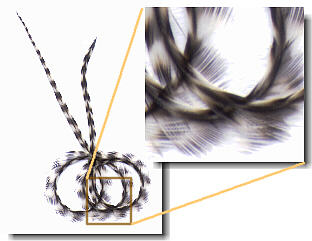
Barb length should be uniform throughout the feather. This genetic saddle feather is almost 7 inches long and will do many flies the same size.
- Log in to post comments

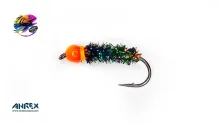

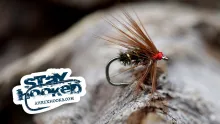
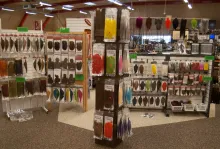
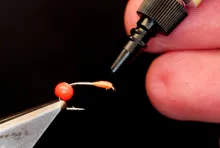
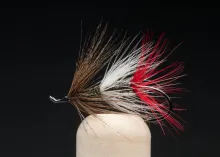

Barry,
That's qui
Barry,
That's quite true. You should always select the hackle to fit the fly. It's the tips that do the magic - whether it's a soft hackle or a dry fly hackle.
A few patterns call for a clipped hackle, but that's to obtain the look that's provided by the clipped off hackle barbs.
Martin
I have read that one
I have read that one should never clip hackle if it is too long. Trimmed barbels will not float as well -- will break the surface tension of the water. Only use the correct length hackle. Is this true??